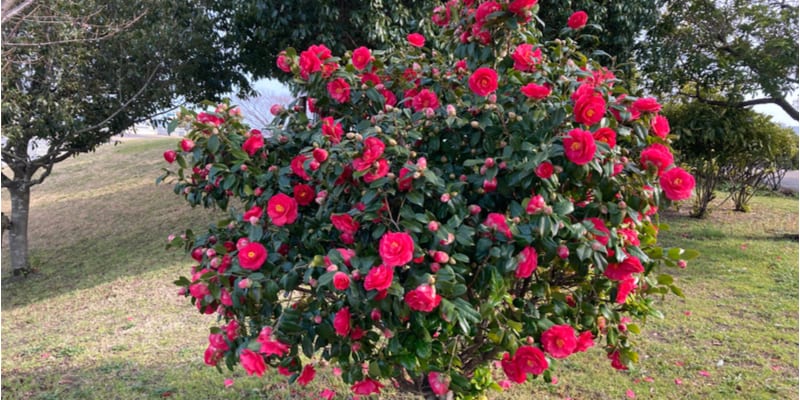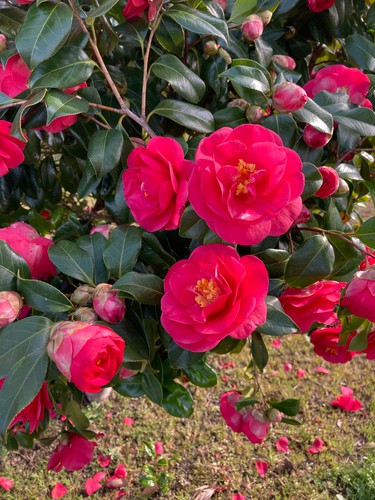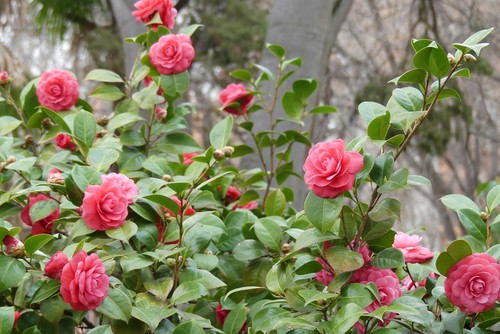
Pruning Camellias to maintain the shape, rejuvenate and remove dead, diseased or damaged growth
Our site is reader supported, this means we may earn a small commission from Amazon and other affiliates when you buy through links on our site.
Camellias are known worldwide for their beautiful blooms and are considered to be one of the best early flowering shrubs that produce a mass of stunning flowers in spring. To maintain their beauty and reign in their growth, Camellias can benefit from annual pruning although it’s not essential.
These evergreen plants benefit from pruning as it aids them in producing better blooms yearly by encouraging new growth as well as getting rid of dead or diseased branches.
So how and when do you prune Camellias? The guide below will be all you need to prune your Camellias successfully so let’s get started.
Why should you prune Camellias?
Camellias are tough plants that will often outlive most people so they can truly be a plant for life; therefore, you might not think pruning is required and that is sort of true. They can grow naturally with little effort; however, pruning ensures they maintain their aesthetic over time.
Pruning allows the plant to shed off dead weight, increase air circulation and allows the sunlight to reach through. By removing the dead weight, you also remove areas where pests and diseases could take root and harm the plant.
If you want your Camellia to thrive for the foreseeable, occasional pruning is necessary.
Best time to prune Camellias
The best time to prune Camellias depends on the variety you have because different varieties bloom at different times. Some Camellias will be pruned months later than others will, especially those that thrive in cold climates. However, the rule of the thumb is that the plants should be pruned right after they have finished flowering, which is usually around May or June for most varieties.
Pruning Camellias before the new growth sets in is perfect, as the plant will focus its resources on the coming flowering season. If you prune too late, you risk cutting off the new growth that is essential for Camellias to flower the following year.
Pruning late after new growth sets in will limit the number of blooms produced in the following season. You can also prune some Camellias in late winter, varieties such as the Camellia sasanqua that bloom in autumn or early winter, which is the exception.
How much can you prune a Camellia?
Camellias are hardy plants which means they can survive tough conditions and they are very forgiving. You can prune back Camellias fairly hard and they will spring back healthier than before. Some varieties such as the seafoam and Sasanqua grow at a faster rate and therefore can take more cutting back. You can remove half the plant and still Camellias will grow back well. As a general rule, established Camellias can be pruned back to around 2ft (60cm) at least and they will respond well.
If you do choose to cut back half of the plant (this is only usually needed if rejuvenating an old woody plant that is bare and just flowers at the tips), expect the blooms to be limited in the next season. After that limited flowering season, the plant will have recovered and be able to produce more blooms.
How to prune Camellias
Pruning Camellias is an easy task that takes a few minutes. Many gardeners including myself, prune Camellias to retain the shape or rejuvenate the plant. All you need is a clean and sharp pair of pruning secateurs or a pruning saw depending on the plant’s age and stem thickness.
As always, make sure that the tools are sterilised to avoid infecting the plant with diseases. After acquiring sterilised tools:
- Create better ventilation for the plant by thinning out the interior branches without touching the main branches. This involves removing thin, dead, or diseased branches; therefore, take your time to observe before pruning.
- After cutting off the unwanted branches, you may want to apply your preferred pruning sealant to prevent the plant from getting infections. I actually don’t use prune sealer and never had any issues myself.
- If you are pruning for shape, snip off the ends of the branches according to the shape you are aiming for. Do this straight after flowering.
- If you want the plant to be larger, prune back the ends of the branches by just an inch. If you want the plant to be smaller, prune the branches back by a few inches compared to the size you want it.
- Those with round camellia bushes should start pruning from the base to get rid of the crawling branches. After taking care of the base, prune more at the top while letting the mid-section remain broad.
Many think that pruning is a lot of work; however, the process only takes place once a year. If you have been thinking of getting Camellias but you are concerned about maintenance, worry not. These attractive plants are low-maintenance especially once matured. They will be the main centrepiece in the garden once those beautiful blooms appear and pruning will not seem like a regrettable action.
Read next: How to prune Acer trees

